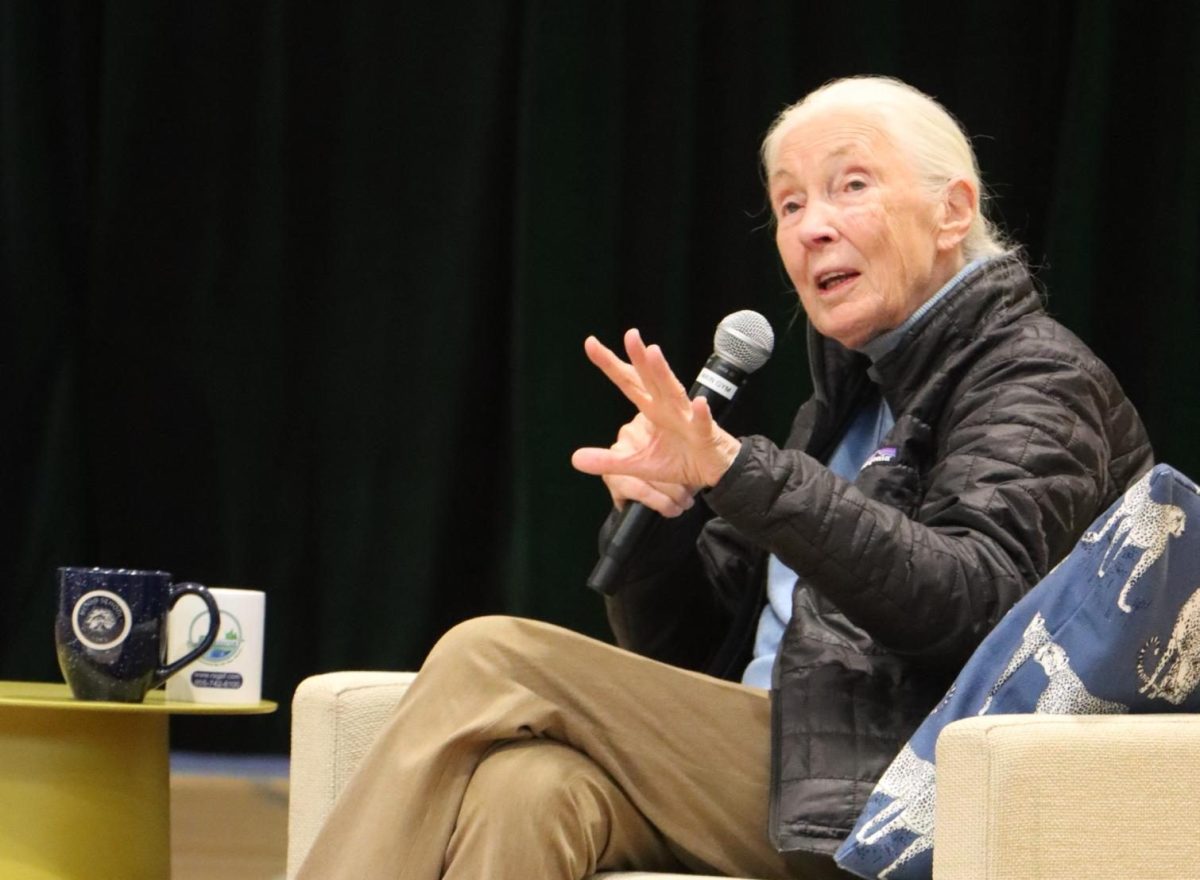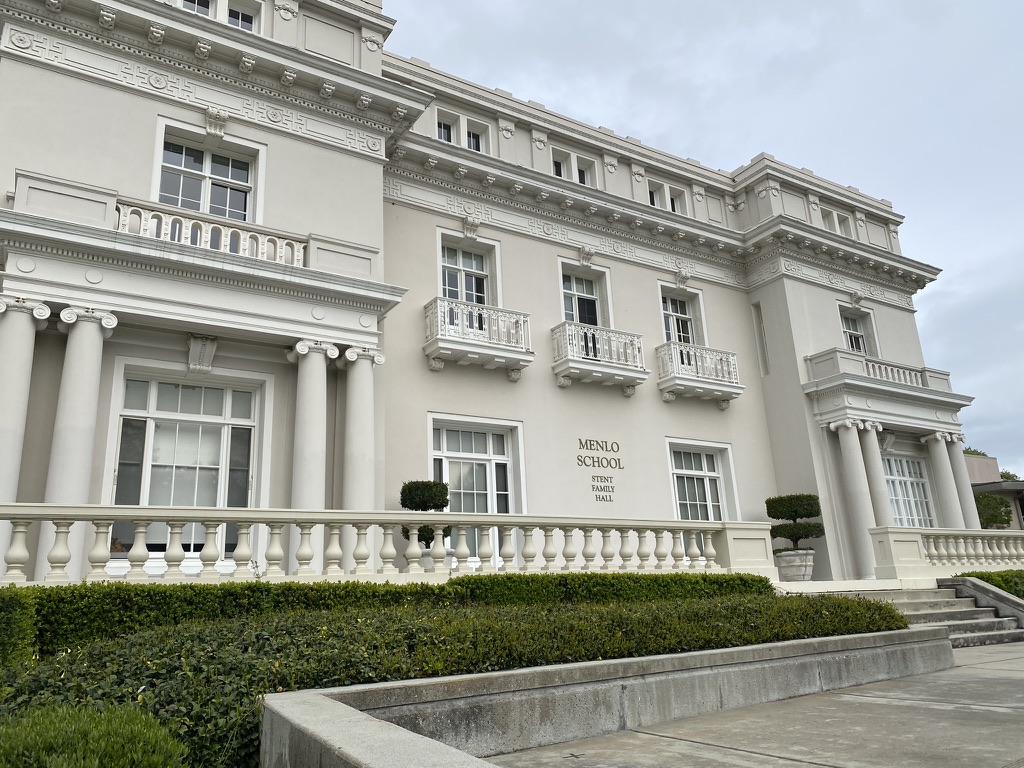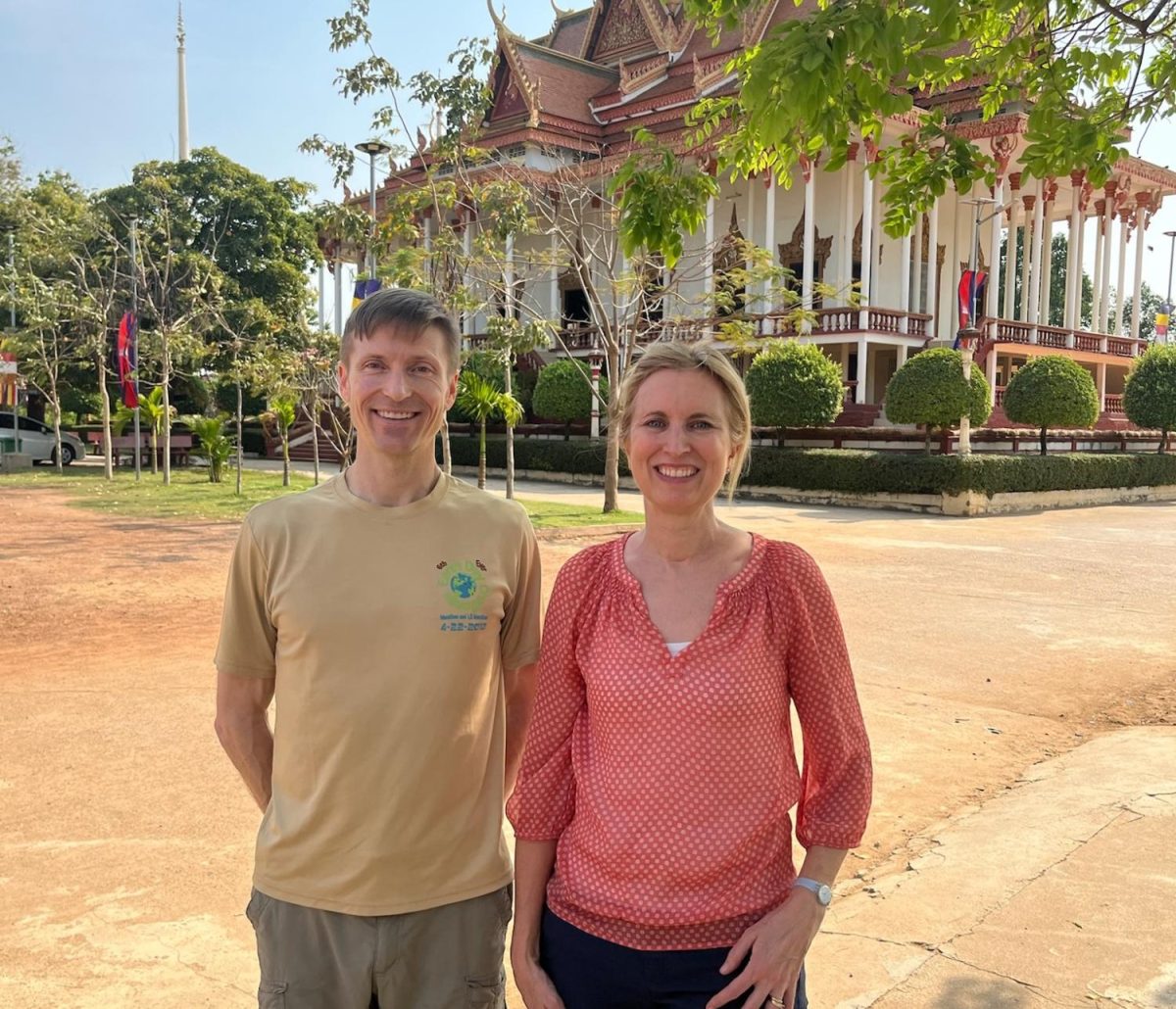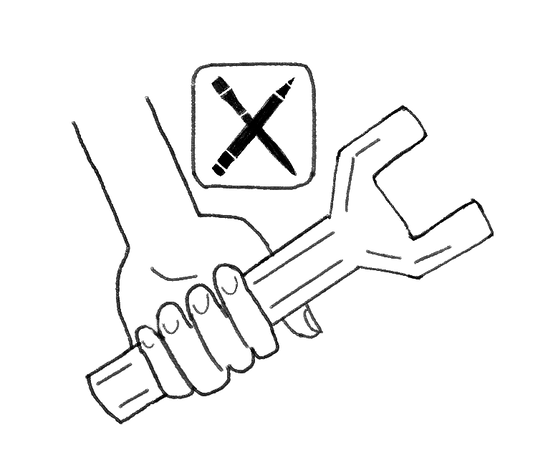College counselor Brad Ward poses for a photo with her brother and father during Ward’s high school years. Photo courtesy of Brad Ward.
By Davis Rich ’16. Updated by Lauren Yang.
Editor’s Note: Brad Ward intended to come out to the community as transgender near the end of 2015. Davis Rich ‘16, last year’s editor in chief, composed the original draft of this article about Ward. However, due to a serious, long-term family medical issue which stabilized last fall, Ward asked The Coat of Arms to hold off publishing this article until now. The article has since been updated to reflect Ward’s current identity, as she currently identifies with female pronouns. Ward has also written a blog about her coming out to the community, which can be read here.
On Jan. 31, the school sent an email to the parents of Ward’s college counselees informing them that Ward will not be returning next year. Asked if her leaving Menlo is related to her gender identity, she responded, “Nothing [like] that has been communicated to me.” Head of School Than Healy told The Coat of Arms that Ward’s transgender identity was not a cause for her leaving.
Brad Ward stood at a trailhead near Lake Tahoe, her heart racing. It wasn’t the thin mountain air nor the summer heat that was making her anxious. It was the fact that she was wearing a skirt. As she glanced over the trail map, she thought about all the people she was going to encounter once she began her hike—people from different countries, with different religious beliefs and political ideologies. Her mind was uneasy, and she couldn’t help but imagine the worst based on the stories she had heard.
What am I doing?
* * *
Menlo School college counselor Brad Ward is transgender. It’s a part of her identity she’s been vaguely aware of for over thirty years and more acutely aware of recently. She first began coming out to friends and family over a decade ago. Last year, she disclosed her identity to the Menlo faculty.
An announcement of this nature usually comes with a series of questions. What’s your pronoun of choice? Will you still go by the name you were given at birth? What bathroom will you use? Will you start showing up to work in miniskirts and makeup? Will you undergo any surgeries?
Ward is “probably going to do away with, but not replace [Mr.] with something.” Note: Ward identifies with female pronouns now. However, she will continue to go by Brad as she likes the name.
As for surgeries, Ward has no plans to do anything drastic. She’s considering electrolysis to remove her facial hair, but that would be it. Regarding any drastic wardrobe changes, Ward will not start showing up to work in a miniskirt and makeup. And as for what bathroom she intends to use, Ward uses the individual stalls in the faculty lounge almost exclusively.
But perhaps the biggest question is what brought her to that dusty trailhead this past summer.
* * *
Ward grew up in a family that her brother, Craig, described as a “conventional nuclear family [with] Republican ‘silent majority’ type parents.” Her parents were supportive and caring, yet Ward formed a tighter bond with her mother because she was around more. Her father worked long hours and often brought her work home. Ward’s mother was the only woman in her family life—Ward had no sisters nearby—even at a time when she “wanted them to be there.”
Since adolescence, Ward has known that there was something different about her. She loved listening to love songs by Journey instead of the rock anthems that her male peers listened to, and she enjoyed hiking and running instead of more traditionally masculine and physical sports like football or basketball.
“I went to a Catholic school, and I wanted to be the girl in the skirt, not [in] the pants,” Ward said. “That’s something I was aware of on some level really early on in my life, but there was no way to identify with it. There was no Internet. So for me, the assumption was that I was gay, and yet, I wasn’t.”
Ward poses for a photo at Mount. Lassen in the snow. This picture was taken after graduation when she was on a trip with her then girlfriend. Photo courtesy of Brad Ward.
Popular fashion of the late 1970s and early 1980s helped Ward mask her identity. Boys had longer hair and commonly wore tight jeans as well as shorts with hemlines more than halfway up the thigh. Ward’s fashion choices during her adolescence were inconspicuous to her peers. However, her close friends noticed she wasn’t “one of the boys.”
“The one thing I did notice about [Ward] that was very different from other men, or other boys […was that] boys that I dated in high school were more interested in video games and stuff like that […]” Kathleen Kemp, Ward’s closest high school friend, said. “But [she] was always more interested in being outside. [She] was very conscientious.”
Ward and a friend smile for a photo in Yosemite after a hike. Photo courtesy of Brad Ward.
As time progressed, boys’ hair became shorter and their shorts longer, bringing Ward’s fashion choices into sharp dissonance with her peers. With no one else like her in the community and no way to better understand her identity, Ward had to put her head down and soldier on.
* * *
Before starting at Bucknell University, Ward hoped that college, with diverse groups of strangers and progressive tendencies, would allow her to explore her identity. She was soon disappointed.
“Very quickly, I learned that college was really no different than high school was, and I thought, ‘You just have to put this aside and stop thinking about it because you can’t do anything with this,’” Ward said. “So I just shut it down.”
Ward hangs out in her college dorm with friends. Photo courtesy of Brad Ward.
Unable to talk with her family, her professors or her peers about the parts of her identity that made her unique, Ward forged a new identity, one that was able to fool even her closest collegiate friends.
“As someone who had just entered college, Brad struck me as someone who wanted to get the most out of Bucknell, and [she] particularly enjoyed meeting and socializing with many students,” Stephen Dwyer, a friend of Ward’s at Bucknell, said in an email. “At least to me, it was not evident that [she] identified more with women more than men, and I really did not know until [she] confided in me many years later.”
Whenever Ward felt the urge to spend time with or identify women, she would overcompensate in the other direction. “I’d be like ‘overly-guy.’ [I’d] start getting really into football and all that kind of stuff which was guy stuff even though it didn’t feel right,” Ward said.
She took advantage of several uniquely collegiate opportunities, becoming a member of a cheerleading team for one year while also joining the Sigma Alpha Epsilon fraternity at Bucknell. During her time at Bucknell, Ward dated women, even admitting that she joined the cheerleading team because she was “totally in love” with one of the female cheerleaders.
To her peers, Ward was a conventional classmate, friend, fraternity brother—obviously with a caring, vibrant personality that her friends appreciated—but a “typical college guy,” as Parker said, nonetheless. Yet Ward progressed through her four years with a burden—the weight of an identity she knew was different, but an identity she couldn’t fully understand or express.
The persona she had to assume on a daily basis was a difficult charade to pull month after month. “You’re not just living in secrecy, you’re living a lie,” Ward said.
* * *
In 2000, Ward started a job in the Bucknell admissions department. It had been nearly ten years since she graduated from college, and many things had changed, such as a new gender studies program, making Ward feel more comfortable with her identity.
Then, in 2003, a friend recommended a book to Ward, called She’s Not There, by Jennifer Finney Boylan. Boylan was named James and assigned as male at birth, publishing under the name James Boylan until 2001, when she began transitioning into life as a transgender woman. She’s Not There was one of the first best-selling books by a transgender American, and it irrevocably changed Ward’s life.
“I read [She’s Not There] in like an afternoon and was like, ‘Jesus, a lot of this is my life,’” Ward said. “And that was the first time I was like, ‘My God, there’s someone like me, somebody who actually understands what I went through.’”
Many times, Ward would go on cross-country road trips and would often go through middle-of-nowhere plainlands. Often times, she would pass farms and see the animals—the chickens, the pigs, the cattle. But, there’d often times be a single horse. With no other farms in sight, that horse doesn’t see anything that looks similar to it. For all it knew, it was the only horse in the world. All it really knew is that it was different. Ward thought of herself as the horse whenever she encountered the single horse on road trips.
Now, enlivened by Boylan’s memoir, Ward trawled through the internet, researching her identity and realizing that she was not the lone horse in a herd of cattle. Ward’s work environment also increased her comfort level. From an LGBTQ+ center to gender studies professors to talk to, Bucknell had become an inclusive setting for Ward to better understand and express herself.
“It helps being in an educational setting because that is, in my opinion, […] as supportive an environment as you can be, because education is about […] educating about the real world,” Ward said.
While Ward became more confident with her identity, she still found it difficult to find the courage to tell her loved ones the nature of her true self. There was still very little trans information on the internet or in popular culture, so Ward couldn’t point out someone in society to compare herself to. “For me, it was hard to have that conversation because I didn’t know what to tell [my friends and family] really about where [my identity] was going,” Ward said. In fact, Ward didn’t even identify as transgender yet (she wouldn’t until about ten years ago, when she arrived at Menlo). All she knew was that she was different.
Ward worried that her conservative parents would sever communications with her, or that friends would consider her identity repulsive and refuse to associate with her. She thought about her cousin living in Indiana, an evangelical Christian, uncertain about what disclosing her identity would mean for the future of their relationship.
Yet Ward saw no resistance. The conversations might have been tense at first, but it was “elation” afterwards. Though her aging parents “didn’t get it,” according to Ward, her other family members and her friends who she told didn’t mind at all. “So finally, I could be myself and know that there were other people like me out there, and I could start to be happy and feel like I mattered,” Ward said.
Ward, her father, and brother smile together for a photo, which was taken during Ward’s high school years. Photo courtesy of Brad Ward.
Additionally, as part of the exploration of her identity, Ward decided to pursue a master’s degree in gender studies in the mid-2000s. The degree she earned through a hybrid program at Skidmore “was kind of a self-psychology,” according to Ward.
“When [she] started studying gender studies in [her] master’s degree many years ago, I think [she] became much more aware of [her] need to start searching for what makes [her] happy and doing things that made [her] happy, which was being transgender,” her high school friend Kemp said.
* * *
Ward arrived at Menlo in 2007 comfortable enough with her identity to wear a skirt on weekends and have honest conversations with family and close friends. Yet her introduction to a new population at Menlo led to hesitation about disclosing her gender identity to the Menlo community. Ward didn’t think students, teachers, or parents would be vehemently opposed to or repulsed by her identity—she just wasn’t sure exactly what their reaction would be, and she didn’t want to risk bringing discomfort to anyone. Privately, Ward assumed the worst—perhaps the divulgence of her identity could lead to a donor withholding a check to the school or a student’s admissions chances at an über-conservative university being “torpedoed.”
“It’s a lot different working at a high school, when you are responsible for the well-being of the students and you’re meeting with them all the time. You’re counseling them,” Ward said. “What you don’t want to do is have them be uncomfortable because the last thing you want is one of your college counselees who doesn’t want to come and see you because of whatever that thing is that they don’t like about you.”
So for eight years, Ward didn’t share her identity with members of the Menlo community. Yet early in 2015, Ward felt her hand was forced.
* * *
In the early hours of December 28, 2014, 17-year-old Leelah Alcorn was struck and killed by a truck while walking on Interstate 71 in southwest Ohio. She was born Joshua Ryan Alcorn to a conservative Christian family. From an early age, Alcorn “felt like a girl trapped in a boy’s body,” but when she revealed this information to her parents, she was stonewalled. What had appeared to be a car accident was actually a suicide. In interviews after Leelah’s suicide, her mother used male pronouns and referred to her child as “Josh.” Leelah’s suicide note included a call to action for society to better understand gender identity issues.
For Ward, Leelah’s death struck a chord. She was from the same area of Ohio where Ward was born. She had driven that stretch of I-71 where she died “hundreds of times.” Ward recognized Leelah’s death as her “call to awareness” about gender and identity issues.
The scope of the problem was larger than Ward could have imagined. “It was like every two, three weeks there would be another suicide or a murder,” Ward said. “I had no idea how regularly this stuff was happening, and it just started to build upon itself.” She began researching information about the trans-community and becoming more attuned to the news surrounding LGBTQ* rights. During that same timeframe, members of the Menlo community were working with the administration to implement gender-neutral bathrooms. Ward began to stockpile all her research and information in one place in case she needed to make a proposal. She has been adding to a lengthy document about trans-issues and daily journaling for her own reference; Ward later hopes to edit and publish her journal entries into an autobiography book.
In April, another suicide hit close to home. Ward had compiled the research and grown more comfortable with her identity. Now, it was time to take action.
* * *
And so Ward stood on the dusty earth, the thin air rich with the scent of aspen, as anxious as ever, yet on a mission. She had every reason to be apprehensive as she took her first steps on the trail, yet every reason to be completely confident in herself as well. For Ward, this was her “defining moment for who I am.” As she stepped onto the trail, she was going public with her identity.
In 2015, Ward hiked California’s most demanding mountainous terrains—Lassen, Yosemite, Tahoe, the Sierra Nevadas—in a skirt. She passed hundreds, maybe thousands of hikers, of all different ages, backgrounds, and walks of life. She didn’t hear one snide comment, didn’t see one passerby flinch or laugh, didn’t see one parent shelter their children. “So to me that was like, ‘Okay, I’m finally doing something here to help,’” Ward said. “For all I know, I passed boys that wanted to be girls or someone who maybe said something later like ‘What was that guy doing wearing a skirt?’” The first few hikes were stress-inducing for Ward. But after passing dozens of fellow hikers without generating a reaction, Ward’s confidence surged.
“All of a sudden everything became that much easier,” Ward said. Ward has become comfortable that she has no qualms about wearing a skirt on trips to Safeway in Menlo Park or to school on days that are not spirit days. She is prepared to respond to the first person who makes a disparaging comment about her appearance. She has plans to ask from a place of of genuine curiosity why they feel the way they do.
* * *
Ward sees herself as a potential role model for trans-individuals in the Menlo community and beyond. However long the strides our country has made towards inclusion of Americans of all sexualities, genders, and identities, the landscape for the trans population remains bleak.
The attempted suicide rate amongst trans- individuals is “45% for 18-44 year-olds,” according to a report about suicide rates among transgender adults. Transgender people face higher poverty rates. “Nearly one-third (29%) of respondents were living in poverty, compared to 14% in the U.S. population,” The National Center for Transgender Equality reports. “16% of transgender respondents report[ed] homeownership, compared to 63% of the U.S. population,” the same study says. The report also says almost half—46%—of trans- individuals have been verbally harassed and 47% have been sexually harassed.
Ward is acutely aware of the odds transgender people are up against, and she wants to be evidence that not every trans- person struggles with poverty, homelessness, or suicidal thoughts.
“There will be one more person out there who people can point to and say, ‘Here’s this successful person who is supported by her school community, and this is working,’” Ward said.
When Ward was questioning her identity, she had no one she could look up to and identify with—the trans-population was portrayed as “extreme” with loud personalities and appearances—which was a significant reason why she chose to suppress her identity. Now, Ward wants to be a source of support.
“For all I know, there is a transgender or questioning student [in the Menlo community],” Ward said. “Given the violence and psychological distress and attempted suicide of the transgender population, I feel like they need to see role models out there. Hopefully I can be that person and let them know that no matter what their difference might be, whether they’re transgender or not, whatever they are, if they’re different, that’s okay because this is the kind of school we are. It reflects our mission statement and everything that we do.”











